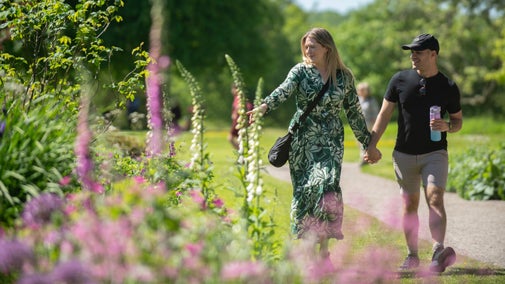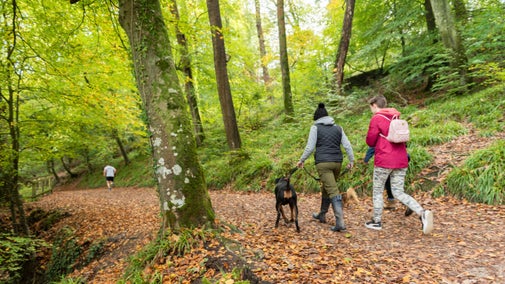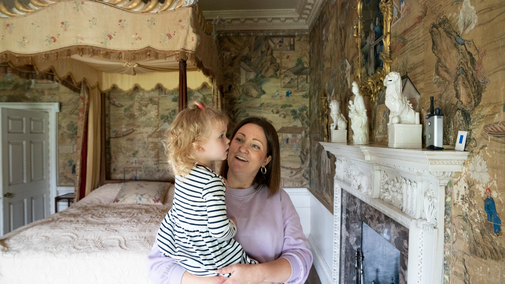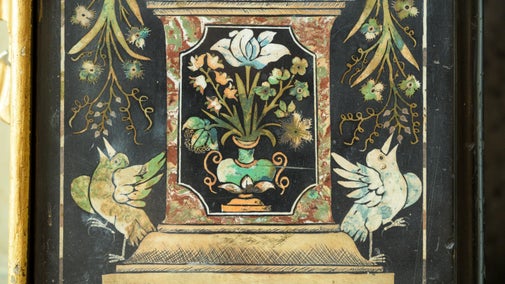
Discover more at Saltram
Find out when Saltram is open, how to get here, the things to see and do and more.

Originally developed as a landscape garden, the Plantsmans’ garden at Saltram, was mostly created in the late 19th century by the 3rd Earl of Morley. In more recent years the garden team have added to it's history of exotic planting, eighteenth century sweeping lawns and woody shady planting. Discover how the Parker developed a fashionable show home, with equal attention paid to the garden and estate. The garden is also home to several historic garden buildings and follies, there is so much to explore!
The garden at Saltram developed at pace along with the house, so much so that Theresa Parker was described as having a ‘planting fit[t].’ New carriage drives were put in, garden buildings sprang up and thousands of trees were planted.
Garden seats looked out along the estuary to Plymouth and up towards their ancestral home of Boringdon.
The 18th century saw a rise in landscaped rather than formal gardens. Made to look natural, many of these gardens were huge feats of workmanship as new lakes were dug and masses of soil moved.
Unlike other estates, Saltram didn’t have to create a new lake or water feature as its position on the River Plym gave a natural feature to the wider garden.

Garden buildings and follies were built for the family and visitors to explore, have shelter from the weather and to host entertainment.
The painter William Tomkins was commissioned by the family to record these views, showing just how proud the Parkers were of the grounds they created. These paintings are on display in Saltram’s garden room.
The most iconic of the buildings, the Amphitheatre was built around 1740 and sits on a semi-circle of land that juts out into the river.
A familiar sight to anyone driving along the embankment or on a train journey to Plymouth, the Amphitheatre can be seen from across the river.
Made for entertainment, the Amphitheatre may have originally contained a covered room for picnicking and music. The garden was a prime location for evening activities.
The Amphitheatre signalled the edge of the Saltram estate and was purposefully placed within a key view across the river.

Oranges are native to China and South East Asia. However, their decorative appearance and exotic appeal means they've been grown in Britain since Queen Elizabeth I’s reign more than 400 years ago.
Initially oranges were planted outside, protected by temporary covers over winter. By the 1670s, permanent buildings were constructed with large, south-facing windows that gave light to the plants.
These plants were grown in movable tubs, which could then be placed outside in the summer.
Saltam’s Orange Grove was created in 1782, when John Parker II and Theresa Parker owned the estate. The grove was built on an area thought to have been the kitchen garden until 1772.
A bill survives from 1772 for ‘taking down Old Garden wall’ and a LiDAR laser survey shows a rectangular form indicating a garden where the Orange Grove is now sited.
- Anne Robinson in a letter to Lord Grantham, 4 January 1782
Saltram’s orange trees were ordered from Genoa and, before the grove was created, they lived in the estate’s orangery. Built in 1773, this orangery was designed by Saltram’s carpenter, Henry Stockman, and based on a proposal by Nathaniel Richmond.
It was tradition for the trees to be moved outside on Oak Apple Day (22 May) and away again on Tavistock Goose Fair Day, which fell on the second Wednesday in October.
By 1863, the Orange Grove had a small oval pool at its centre with a fountain. The fountain was enlarged about 20 years later, when Albert Edmund 3rd Earl of Morley and Margaret Parker began developing Saltram’s garden.
According to Saltram’s planting journal of 1886, the gardeners planted tender plants from Westonbirt, Whiteway and the Scilly Isles in the Orange Grove.
The 1888 journal includes a small drawing of the orange trees arranged in a cross centred on the pond, which was bordered by rows of orange trees in tubs.
Photographs show that a rockery was created in 1893, which fringed the pond and had rockery plants tucked between. However, it was removed after the 1930s.
Saltram’s garden featured in the Gardeners’ Chronicle in 1903. It described the Orange Grove as being filled with about 30 orange trees, some 12 foot high and almost as much in diameter, and 100 years old.
The layout of the Orange Grove today is similar to how it looked from the late 19th century to the 1930s. However, today’s planting is not as large and wall-like as what’s seen in those early photographs.
The National Trust imported new orange trees from Italy in the 1960s and placed them in tubs based on the design of a slate plant trough in the ‘Tudor’ courtyard. Today, Saltram’s Orange Grove continues to provide a peaceful communal space.

Find out when Saltram is open, how to get here, the things to see and do and more.
Built as an 18th century summer residence, Saltram’s historic interiors are just as beautiful today as they were; browse the shelves in the Library and see architect Robert Adam’s designs in the Saloon.

See what there is to discover among the collection at Saltram, including fine examples of Wedgwood ceramics, intricate Chinese wallpapers and portraits by Joshua Reynolds.

Discover what there is to see and do in this garden full of seasonal scents and bursting with colour, with views across the River Plym and beyond.

Woodland, estuary and open green spaces provide the backdrop to a city escape as you explore the beautiful countryside nestled near Plymouth’s urban environment.

Feast your eyes on Robert Adam’s neo-classical saloon, lose yourself in stories in the Chinese wallpaper and wonder at the sheer volume of books in the library.

Learn about people from the past, discover remarkable works of art and brush up on your knowledge of architecture and gardens.

Explore the objects and works of art we care for at Saltram on the National Trust Collections website.
